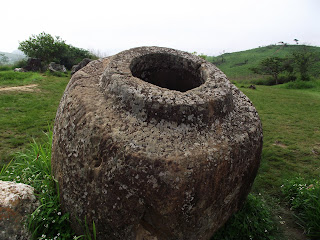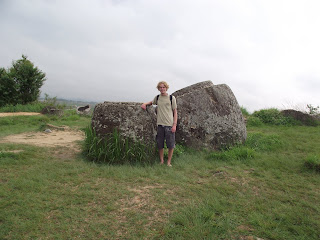Once again, it's been a while.
I know how much you crave these tardy blog posts, so I've sat myself down at a computer in Cambodia and started with the catch-up. No, I'm no longer in Laos. But I will be typing up a blog post about everything I have yet to blog about in Laos. I've only been in Cambodia for 20 hours so I can hardly add anything of worth.
I believe I left you all (waiting with baited breath, no doubt) about a week ago in Vientiane. So, here begins my catch-up, or rather - yours.
 |
| Wat Mixay, Vientiane |
Vientiane, the capital city of Laos, home to only 300 000 people, is one of the smaller cities in Southeast Asia. It is a beautiful city, but for some reason I didn't really like it. It lacks the charm inherent to Luang Prabang and it isn't nearly alive enough to be anything like Saigon. Sadly this makes it fall somewhere in the middle, a bit of a grey zone. The French influence is very apparent and you can't help but wonder, when wandering, if Vientiane is an Asian city trying hard to be French or a French city striving to be Asian. It was a puzzling phenomenon to say the least. Next to a French-style bakery one can find a mobile shop selling distinctly Asian dishes, my favourite being deep-fried mango (Yes, they have that and yes, it is amazing).
 |
| Haw Pha Khaw museum |
Schizophrenic though it may be, Vientiane had a lot on offer in the sightseeing department. Being a tourist it was my obligation to see sights and so I did. I donned my finest
farang tourist gear and headed out, taking photos like a Japanese tourist. My first stop was at an old wat which had been converted into a museum, housing over a thousand buddha images. The museum building was, for me, more interesting than the buddha images. It was a fantastic, old wat with beautifully adorned windows and doors and a flowing garden out front.
After the museum, I did a quick hop across the road to Wat Sisaket, the oldest wat in Vientiane. It was, sadly, just another bleeding wat. I've seen so many. It did have a 'library' which used to contain buddhist scripture. The scripture has long since been removed, and the library (which is nothing more than a cramped room) has been gathering layers of dust over the years. The library is outside the main wat compound, around a corner and virtually no tourists bother to go there as it isn't immediately visible. It was by chance that I stumbled into it on my way out. The reason I was heading out was the Arc de Triomphe. Vientiane has one. An Asian version of the French monument, actually called Patuxai. It is apparently a few metres taller than the actual Arc de Triomphe, which is typically Asian. Perhaps you're starting to understand why I thought Vientiane was schizo... The views from the top of Patuxai are the best on offer in Vientiane. A full 360 degree view of the city is gifted to all people who climb the seven stories to reach it. And the view truly is fantastic. The city unfolds around you, monuments can be spied off in the distance and the buzz of cars drifts up to you from the main boulevard.
 |
| Patuxai, Asia's Arc de Triomphe |
I left Vientiane behind after just 2 days. I left on a night bus to Pakse. My plan was originally to spend a day in Pakse and then head to Champasak the next day. It was early morning when I arrived in Pakse and I knew that buses and
sawng thaew (converted pickup trucks with 2 rows of seats in the back) leave every morning for Champasak from the new market. Pakse didn't look too charming so I headed straight to the new market to find transport on to Champasak. I found a guy who was taking his
sawng thaew to Champasak and asked when it departed. He told me 10 AM. It was 7AM. I spent the next 3 hours in the bustling morning market, it was a distinctly Asian experience and was truly brilliant. At 10 o'clock I (and 22 other people) climbed into the back of the
sawng thaew and headed for Champasak.
About an hour later I arrived in the sleepy town of Champasak. There is only one road through the whole town and the main traffic on it is herds of water buffalo. It was such a perfect place to be. There were almost no other tourists.
The nearby Wat Phu Champasak was the main attraction. It is a very large temple which predates Angkor Wat and is believed to be the blueprint from which Angkor Wat and other Khmer temples were built. About an hour after I arrived I went to find a place from which to hire a motorbike. I found a guy who would rent one out and bargained for a half-day price. Fifteen minutes later I was on a motorbike, cruising to Wat Phu.
 |
| The main walkway to Wat Phu |
Wat Phu blew my mind. It is a powerful structure, built on a hill to overlook the Mekong and its flood plains. It is almost unimaginable to believe that it has been standing there for over a millennium, in a constant battle with the ravages of time. It is being restored, but much of what is there has been standing since it was built. A brisk walk up to the top of the hill gifts you with fantastic views of the Mekong River and surrounds. The vastness of the compound becomes apparent when you look over it and see the massive
barays (man-made lakes) stretching out in front of you. Walking around the upper complex you will find intricate carvings of an elephant, a crocodile and buddha's footprint in the rocks. There is an aqueduct which brings water from a spring near the peak of the mountain and buddha statues protected from the elements in little caves.
What was also mind-blowing was that there were almost no other tourists there. There were some local tourists from Vientiane and an Englishman who was cycling in and around Southeast Asia.
 |
| A view from the top. Those square lakes are barays. |
 |
| A crocodile carved into the rock |
 |
| The main temple building |
 |
| A look down on the main temple building |
The next day in Champasak I spent doing the only thing one can do in such a place, read. The town is always quiet and once you've found your spot on the Mekong, under a tree you're sorted. I arranged my ticket to Don Det and just relaxed the day away. There was nothing else to do, it was superb.
Don Det possibly the most relaxed place on the planet. It is a tiny island in the Mekong River, part of Si Phan Don (4000 Islands). I arrived on Don Det just before midday and the whole place was silent. There was not a breath of wind nor the sound of a car. Boats puttered around on the river, but everything else was still. This was Don Det life. I walked down the sunrise side and found a place to stay. Almost all accommodation on Don Det is in the form of single-room, wooden bungalows over the river. On the balcony of each bungalow there are hammocks for lazing around in. I did what any sensible person would do, I lazed.
 |
| Don Det bungalow, hammocks are a necessity |
On day one I lazed and read. On day two I lazed and read and booked my ticket to Siem Reap. On day three I lazed and read. I was almost finished both my books and was trying to read slowly to make the last pages stretch to the next day. On day four I rented a bicycle and pedaled my way over to Don Khon, the island directly south of Don Det. On Don Khon I went to the spot where one can see Irrawaddy dolphins, there weren't any. I then pedaled my way back to Tat Li Phi (Spirit Trap Waterfalls) and was instantly amazed by what I saw. Tat Li Phi is a series of waterfalls, not tall but long. They stretch for almost half a kilometre and thousands of tons of water cascade down every second. They are some of the most fantastic waterfalls I have ever seen. I chilled out at the waterfalls, just listening to the water crash down. It was a perfect way to bring my time in Laos to an end. A beautiful place in a beautiful country.
 |
| A small part of Tat Li Phi |
The next morning (yesterday, as I write this) I picked up my bags, jumped on a ferry and left the island. 2 hours later the bus arrived to take me to Siem Reap. At 11 o'clock I was out of Laos and into Cambodia. At six in the evening the bus dropped all the passengers who were traveling to Siem Reap off in the middle of nowhere. 75km from Phnom Penh, 250km from Siem Reap. We waited for 2 hours. Another bus came and picked us up and took us to Siem Reap. 16 hours after departure, at midnight, the bus arrived.
Oliver
P.S. During those 2 hours stop over I ate a grasshopper. Here's a couple of pictures:
 |
| Stage 1 - mental preparation |
 |
| Stage 2 - execution |
































